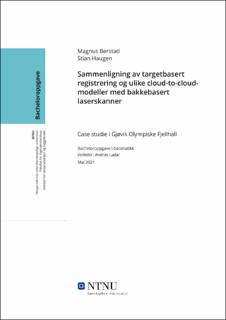| dc.contributor.advisor | Ladai, Andras | |
| dc.contributor.author | Berstad, Magnus | |
| dc.contributor.author | Haugen, Stian | |
| dc.date.accessioned | 2021-09-24T19:25:36Z | |
| dc.date.available | 2021-09-24T19:25:36Z | |
| dc.date.issued | 2021 | |
| dc.identifier | no.ntnu:inspera:77257076:81956531 | |
| dc.identifier.uri | https://hdl.handle.net/11250/2782311 | |
| dc.description.abstract | Dagens krav til dokumentasjon og effektiv tidsbruk har gjort laserskanning til et verdifullt datafangstverktøy. I tillegg har teknologisk utvikling gjort både instrument og prosesseringsverktøy stadig mer nøyaktige og effektive.
Registreringsmetoden cloud-to-cloud bruker algoritmer i programvaren til å sette sammen de ulike punktskyene. Dette gjør at en ikke behøver å benytte targets. Det kan gi stor tidsbesparelse. Spørsmålet har gjerne vært hvorvidt denne metoden er like nøyaktig.
I denne oppgaven sammenligninger vi targetbasert registrering og ren cloud-to-cloud, for å vurdere kvaliteten med targetfrie metoder på et større innendørs prosjekt med utfordrende geometri.
Check points ble benyttet som kvalitetskontroll for laserskanningen. Disse targetpunktene ble målt inn ved hjelp av polygondrag gjennom anlegget, med utgangspunkt i et grunnlagsnett på utsiden av Fjellhallen. Det ble gått et tilsluttet polygondraget fra et fastmerke ved Fjellhallinngangen, gjennom interesseområdet, og til et annet fastmerke på utsiden av svømmehallinngangen.
I alt seks modeller analyseres, hvor én er targetbasert og de andre ulike versjoner av cloud-to-cloud. Ved registrering kan en velge hvilke koblinger som skal benyttes. De ulike cloud-to-cloud-modellene brukes for å undersøke effekten av ulike valg, og hva som kan bidra til å optimalisere metoden.
Resultatene viser at targetbasert registrering i gjennomsnitt har 1-2 millimeter lavere romlige avvik i check points, enn cloud-to-cloud-modellene. Avvik i høyde er større ved bruk av targets, mens grunnrissavvik er større med cloud-to-cloud. Denne tendensen gjelder for alle cloud-to-cloud-registreringene, selv om størrelsesforskjellen varierer.
Forskjellen mellom ulike cloud-to-cloud-modeller innad er like stor som mellom cloud-to-cloud-registreringene generelt og targetregistreringen. Den tilsynelatende kvalitetsforskjellen mellom metodene er altså tilsvarende usikkerheten ved den enkelte metoden. Det viser at cloud-to-cloud kan gi sammenlignbar kvalitet som ved bruk av target, selv på et stort prosjekt med utfordrende geometri. | |
| dc.description.abstract | Current requirements for documentation and efficiency have made laser scanning a powerful and valuable tool for geometric data capturing. Additionally, technological advancements have made the scanner instrument and processing software ever more accurate and efficient. Cloud-to-cloud is a registration method that uses algorithms in the software to tie the point clouds together. This method does not require artificial targets to be used, which can prove vastly cost-effective. The doubt has been whether the method is equally accurate to the target-based method. In this paper the methods of target-based and target-free registration is compared, to evaluate the quality of target-free methods on a large scale indoor project with challenging geometry. Check points were applied as quality control for the scanning data. These targets were given coordinates by traversing through the site, based on a ground control network outside of Fjellhallen. The link traverse begins in a known point outside the entrance to Fjellhallen, goes through the area of interest, and ends in another known point outside of the entrance to the swimming pool. A total of six models are analysed, one target based and the others different variations of cloud-to-cloud. A selection of what scanning links to used when performing registering is required. The different cloud-to-cloud registrations are used to investigate effects of the different choices, and what choices serves to optimize this cloud-to-cloud method. Results show that target-based registration on average has 1-2 millimetre lower spatial deviations in the check points from the reference model, compared to the cloud-to-cloud methods. Height deviations are bigger in the target model, whereas deviations in the XY plane is bigger in the cloud-to-cloud models. This tendency is repeated in all models, but the magnitude varies. The variations within the cloud-to-cloud methods are equal to the overall difference between the target based and target free registration methods. The seeming difference in quality between the methods is therefore equal to the uncertainty of the cloud-to-cloud method itself. This indicates that cloud-to-cloud can provide results of comparable quality to that of target-based registration, even on a large scale project with challenging geometry. | |
| dc.language | nob | |
| dc.publisher | NTNU | |
| dc.title | Sammenligning av targetbasert registrering og ulike cloud-to-cloud modeller med bakkebasert laserskanner.
Case studie i Gjøvik Olympiske Fjellhall | |
| dc.type | Bachelor thesis | |
